Garden Designers Roundtable: Contrast textures to make a good garden better
Even the smallest vignettes benefit from strong contrasts of texture. Take this tabletop display, for example. The slick zinc tabletop contrasts with a nubby lace doily, and the spiny cactus contrasts with the smooth, ceramic pot.
If you use design techniques to bring greater interest to your garden, you may already know that employing contrast is a good way to achieve it: contrasting leaf and flower forms (globes versus narrow spires, for example), contrasting light and shadow (creating a tunnel of shade with a vine-covered arbor, leading to a sunlit garden), and contrasting colors (green and red, blue and orange) to amp up the excitement. But how often do you think about contrasting various textures in your garden?
Texture is visual and tactile; you can see and feel the relative roughness, smoothness, slickness, and furriness of leaves, stones, wood, even outdoor furniture—in fact, any feature of your garden. Maybe you’re not consciously considering the texture of particular elements in your garden, but I bet you notice it nonetheless. Don’t we all run our fingers across fuzzy leaves, feathery grasses, rough bark, satin petals, and smooth pebbles? It’s one of the pleasures of the garden! Even young children do this, and we never outgrow it.
Here are a few examples of how to contrast various textures in your central Texas garden.
Pair sword-like, spiky leaves with soft, billowy foliage, like this ‘Color Guard’ yucca mingling with copper canyon daisy (Tagetes lemmonii)…
…and the smooth, broad leaves of ‘Whale’s Tongue’ agave (A. ovatifolia) with the fine texture of Mexican oregano (Polomintha longiflora) and rock penstemon (Penstemon baccharifolius).
Plants aren’t the only things that add texture to a garden. Hardscape materials like stone, wood, and metal add a tremendous amount of texture. In this garden, owner Jeff Pavlat contrasts a pebbly bed of river stones with a smooth limestone patio and a water-slick millstone. You can practically feel the texture of this scene with your eyes!
Similarly, in my own former garden, I used rock to create textural contrast: a nubby arrangement of Mexican beach pebbles paired with smooth, flat limestone.
Consider the texture of decorative objects in your garden as well: slippery glazed-ceramic pots, rough terracotta, bamboo screens, rusty wrought-iron trellises, etc. I like to contrast the slick, smooth texture of galvanized steel—used here on the shed roof, the culvert-pipe planters, and the stock-tank pond—with rougher textures in the garden, like gravel and stone paving and large limestone boulders. The ridges in the steel also give it a touchable texture, even if you only “touch” them with your eyes.
Don’t you want to touch everything in this tactile driveway garden (Munsterman garden)? Smooth culvert-pipe planters and the smooth stems and leafy foliage of the bamboo planted in them; chunky Opuntia paddles and feathery dianthus foliage beneath; even the pebbly pea gravel—all invite the fingers and eyes to linger.
Gabion walls—steel-framed boxes filled with rocks—are trendy in gardens today, and they add a lot of texture as well. In this Marfa, Texas garden, chunky gabion walls contrast with smooth, concrete retaining-wall seating. Of course, the spiky globes of Yucca rostrata and their shaggy trunks add even more touchable texture to the scene.
I hope this has given you some ideas for contrasting texture in your own garden. If you sense a dullness about a particular planting bed, pay attention to whether the leaves all have the same texture, whether shiny, smooth, rough, or spiky. If so, try mixing it up a little and watch how contrasting textures brings new life to your garden.
This is my contribution to today’s post on Texture by Garden Designers Roundtable. Click for links to other designers’ posts from around the U.S. and England.
Thomas Rainer : Grounded Design : Washington, D.C.
Rebecca Sweet : Gossip In The Garden : Los Altos, CA
Lesley Hegarty & Robert Webber : Hegarty Webber Partnership : Bristol, UK
Douglas Owens-Pike : Energyscapes : Minneapolis, MN
Deborah Silver : Dirt Simple : Detroit, MI
David Cristiani : The Desert Edge : Albuquerque, NM
Christina Salwitz : Personal Garden Coach : Renton, WA
Andrew Keys : Garden Smackdown : Boston, MA
Rochelle Greayer : Studio G : Boston, MA
All material © 2006-2012 by Pam Penick for Digging. Unauthorized reproduction prohibited.


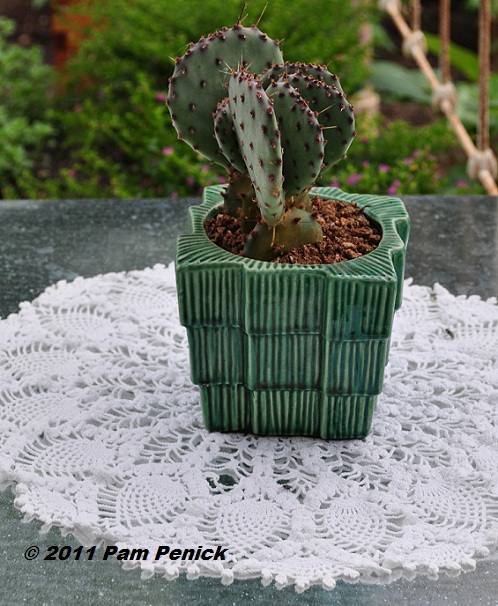
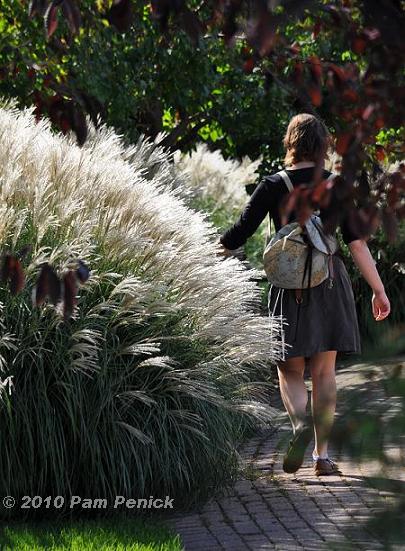
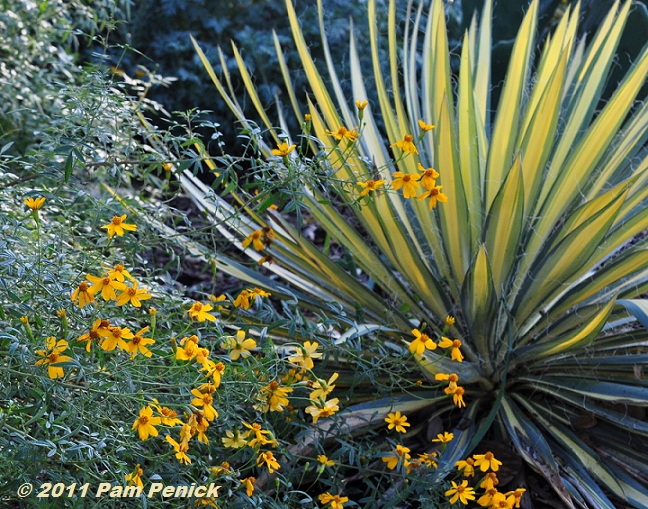
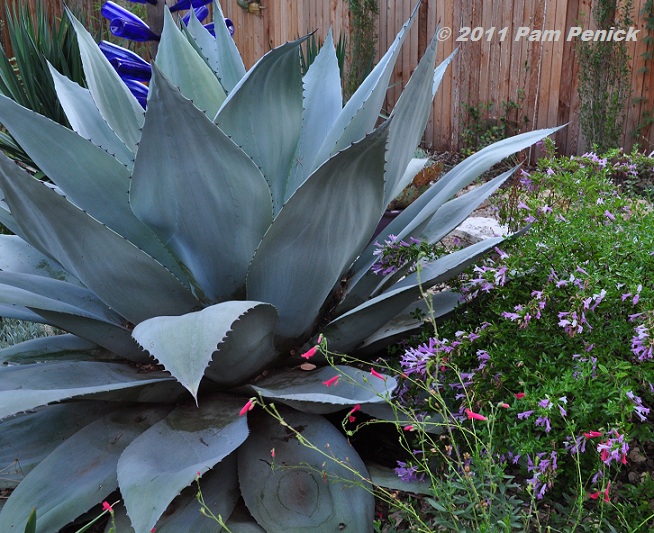
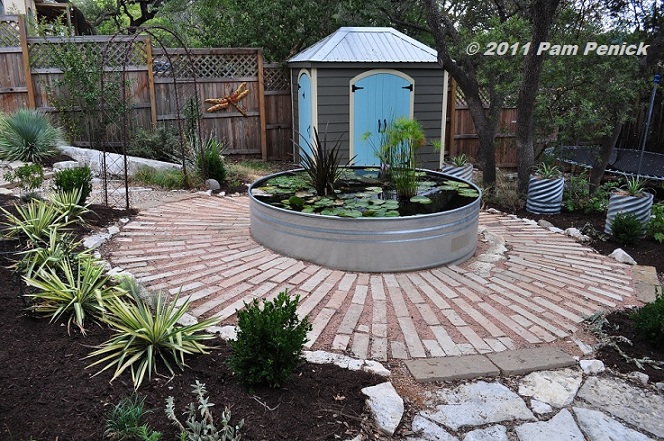
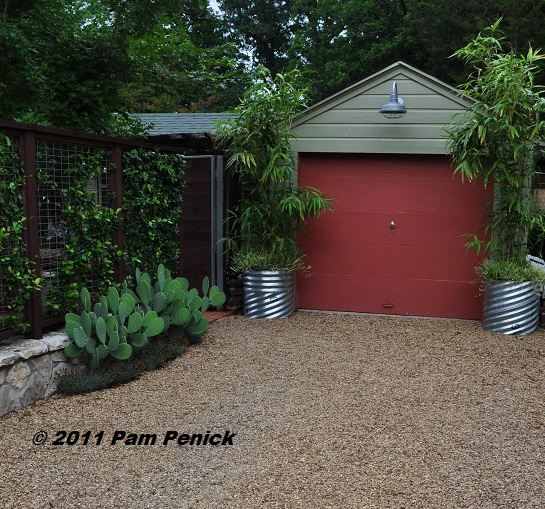
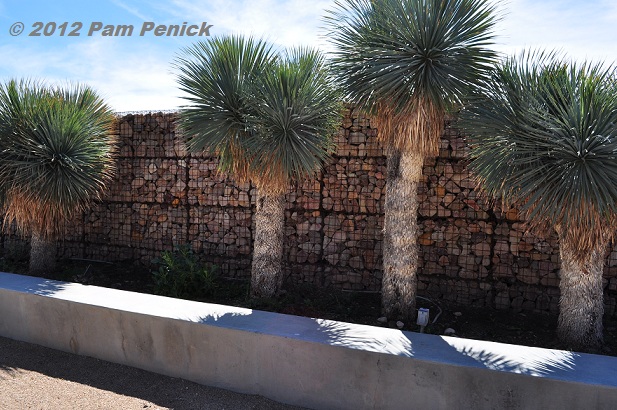
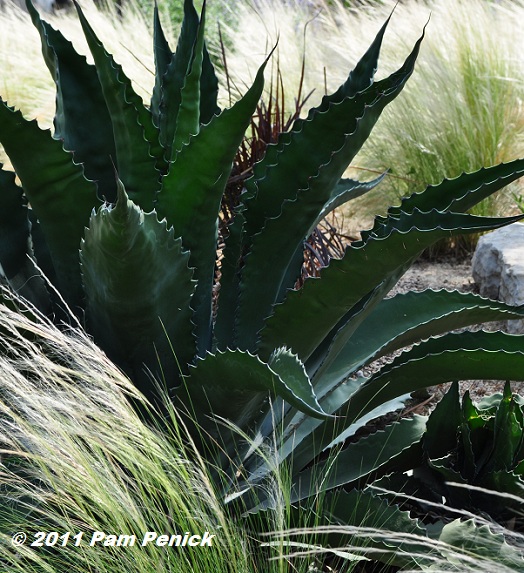
Very nicely done, Pam. Wonderful to see your definition of texture included hardscape elements as well as soft ones. I love the image of the woman running her hands through Miscanthus. Very evocative!
Thanks, Thomas. I’m always running my hands across grasses too. Don’t you? —Pam
Pam,
The culvert-pipe planters are just pure genius! That’s the wonderful thing about blogs and visiting the gardens of others. So many, many fantastic ideas.
Aren’t the culvert-pipe planters fun, Randy? I love using industrial “junk” in the garden. —Pam
Love the contrasts you shared, so many textures and colors, all working so well in the landscape. Think my favorite combination is the agave and stipa in the last picture. Stipas have been ‘talking’ to me this summer….need to add more!!
Yes, Mexican feathergrass is one of my favorite plants, and so tough too. —Pam
I’m so glad you showed several examples of excellent sources of texture provided by hardscaping – a tough concept for some to grasp. The photo of Jeff Pavlat’s garden is to die for gorgeous!!!
His whole garden is to-die-for gorgeous, Rebecca. Lots of good examples there for many Roundtable posts. 🙂 —Pam
My favorite is the photo from your former garden, Pam. I love the way you arranged the beach pebbles on their sides; and the pot cannot be improved upon, either in scale, shape, or the continuance of neutral color, the unifying aspect of this arrangement. Just perfect!
Thank you, Sandy! You know, that was an easy project to do, and it always got so many compliments. —Pam
My favorites are the agave with small flowers and grasses — great photos as always. It’s fun to travel with the blog group, now that I can fully appreciate “composition”, with some idea of how the various plants can and will combine together as we paint with plants on the canvas of our unique central texas gardening environment.
It’s both unique and tricky, isn’t it, Tom? But we do have some wonderfully textural plants to work with, which other regions can only covet. —Pam
Wonderful examples and you’ve got me ready to go out to my garden and size up my use of texture!
Oh, I think you have the texture thing all figured out, Loree! I could have pulled any number of examples from my pics of your garden from last summer. —Pam
Well done.
It’s good to see all the examples of texture. Mixing textures make an area more interesting…inside and out.
Since foliage is so important in my garden, I try to mix up those textures. I do need more texture in the hardscapes, though.
Great ideas.
Thanks, Linda. Once you start noticing textures, you want to add more and more. —Pam
Pam, Great job as usual! what’s the name of the plants in the second contrast picture. I love the picture.
Ping
I knew someone would ask me that! 🙂 That picture was taken at Chanticleer Garden in Pennsylvania, so the plants are foreign to me. But I think the lower one is some sort of euphorbia. Maybe someone else will be able to ID them for you. —Pam
Oh Pam, you are SO truly gifted. I worship at your Designer feet! I loved this post. Swoon!
Oh, Christina—you flatter. Thanks for the encouragement. 😉 —Pam
Thanks for the texture lesson, Pam! Yes, makes me want to go and look at my garden thru this lens. I think I’ll wait until the morning, though, when it’s not 100 degrees. Becky
I heartily agree. It’s WAY too hot out there right now to do anything more than read about gardening. —Pam
Another fabulous post Pam and you have given me a lot to think about!
I’m glad to hear it, Candy. Here in Texas, summer is a good time for thinking about gardening, rather than actually gardening. 😉 —Pam
Wonderful examples of your bold and beautiful Texas gardens! I agree that contrast is the name of the game when it comes to texture…
Thanks, Jocelyn. —Pam
Dear Pam, you photographs are great, and they say so much about what you are seeing when you look, and when you design. I always have to ask myself if I am being bold enough with a design idea-you have bold coming out of the ends on your fingers! Thanks for this post, Deborah
Deborah, I like a bit of excitement in my home garden, as you can see. But I often envy those who have the discipline of restraint and create restful oases for themselves. Wouldn’t it be wonderful to have room to have it all? —Pam
Inspiring post and beautiful pictures! Thank you Pam. 🙂
Thanks for your comment, Debbie. —Pam
Good exploration, not to mention what I might show to the nth degree! Tactile is important, though I do it more for scents than feel. I feel like every photo is what an oasis wants to be where I am, but I know I’m home in the Marfa photo!
It’s helpful to remember that even when it’s dry, dry, dry in Austin, there are still-drier gardens in your region, David. Beautiful ones too. —Pam
I really REALLY need to pay closer attention to texture – thank you for this post! I really love your plant combos and I especially love that small potted cactus – unexpected… big cactus in a little pot. Looks so cool!
I love that potted cactus too—the whole vignette was so sweet. Did you know that the table is actually a beehive?! Check it out at my post about the Blue Lotus Garden in Dallas. —Pam
Hi Pam,
Yeah you are right about upping the ampage. Some of those egs were hot!!
And that pond of yours. I am still craving that!
And all those dry zone plants that you and David show. I used to grow all those in my ‘evil head gardener’ days, UNDER GLASS here in rainy UK. Great to see them all again.
Great post.
Thanks
Best
R
Hi, Robert. I hear about the lengths to which agave-crazy gardeners in colder, wetter climates will go to grow them. The next time I get all woe-is-me about the heat and drought, I will remember to feel fortunate that we can grow these beautiful plants so easily. —Pam
Wonderful post, Pam…love that shot of the woman running her hands through the Miscanthus…so wonderful (and so ME)! I’m such a lover of fine texture…but really need to work on adding some bigger/rougher texture in there as a counterpoint 🙂
Have Loree and I not convinced you that you need an agave or two yet, Scott? I’ll keep working on it! —Pam
Hi Pam, I am an Austinite too! I bought a house down in South Austin about 4 years ago and I’m slowly working on making it more xeriscaped. I’m having a lot of trouble keeping everything from burning up! I was very interested in the picture of the Gabion wall. I would love to do something like that to replace my worn-out wooden privacy fence. Is there a place in Austin where I could get the materials for the Gabion wall? I know where to get the stone, it’s the wall itself I’d like to find.
I love your blog, keep up the good work! I’m inspired to go out in the 100 degree heat and water all my poor plants!
Terese
Hi, Terese. Thanks for commenting! Try using cattle-panel fencing to make your gabion walls. You can find it at Callahan’s General Store in Austin. It’s a rigid, heavy-duty wire fencing material, which you can cut with heavy-duty bolt cutters. You’ll have to figure out a way to attach the pieces to each other to make a box for the stones—maybe strong galvanized wire would hold it? As for keeping your new plants from burning up, yes, it’s difficult at this time of year for new gardens. Just remember to water slowly and deeply rather than just sprinkling water over the whole bed. Stick your finger in the soil to make sure it’s damp several inches below the surface before you stop watering. Good luck with your new garden! —Pam